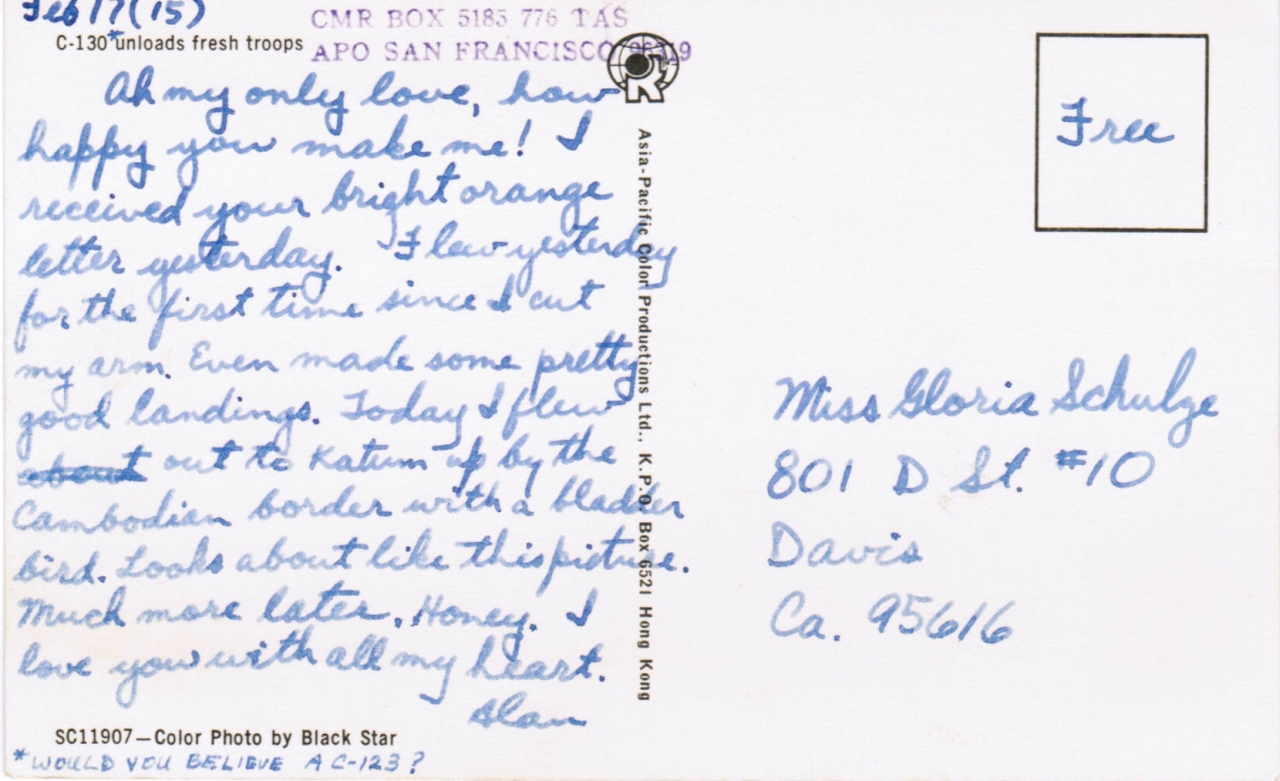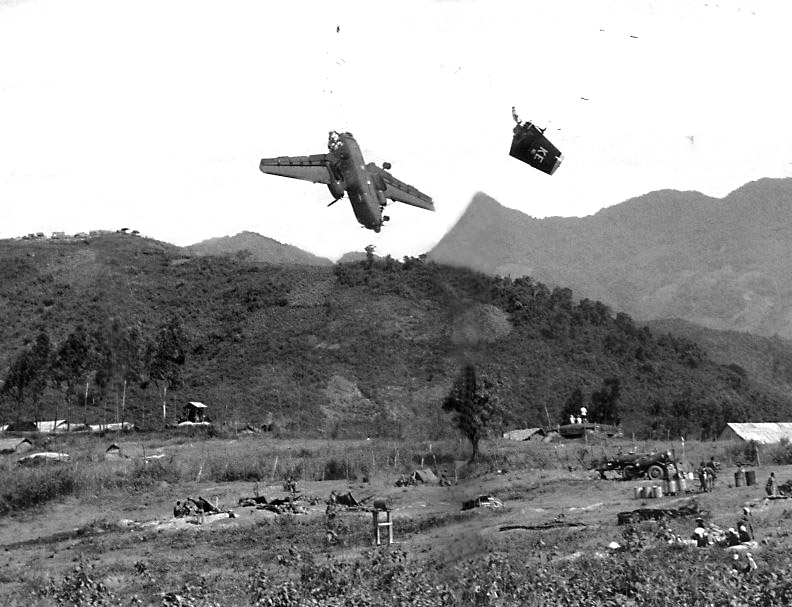Postcard from Katum, February 17, 1971
Katum was pretty remote--about 4
miles from Cambodia. The VC operated freely back
and forth across the border bringing weapons large and small to
shoot at big targets like C-130's. To make the VC easier to
spot, the USAF defoliated the nearby jungle with Agent Orange--note
the
dead
trees just beyond the runway.
Katum was known as a hot spot for hostile fire. A couple
of years earlier the VC hit a C-130 on departure there, and they
crash landed at nearby Tay Ninh.
Pat
Hatch's story is hair-raising.
Katum's runway was shorter
than most--
3000' of red dirt
treated with
Peneprime
to keep the dust down. The soil there is called laterite and
it is red because of the high concentration of iron.


Combat Essential, February 21, 1971
Army helicopters operating out of there needed fuel, and it was too
hazardous to send tank trucks through "Indian Country", so we
brought it to them. These flights were called "bladder
birds". Sometimes we brought the fuel in 2' diameter round
bladders called "elephant balls", which could be rolled if
necessary. But usually we carried the fuel in two 18'
lozenge-shaped bladders, and pumped the fuel out to trucks at the
destination.
The airplane's landing weight determined the length of its landing
roll, which was quite limited at small fields like Katum.
Based on the field length we calculated our maximum rollout, and
from that we determined how many tons of fuel we could bring in.
"Normal" short field landing criteria are different from "combat
essential" landing criteria. If your mission was high priority
(combat essential), thinner safety margins were acceptable.
Max gross weight for normal short field landings was calculated
assuming 2 props in reverse and 2 in ground idle. For combat
essential missions we calculated the landing rollout assuming all 4
in reverse. This increased the allowable gross weight (and the
possibility of going off the far end of the runway if something went
wrong).
My
nav
comes on a little strong sometimes (his nickname is King
Kong). He would make a good AC--he is sharp but
occasionally I have to remind him that he's the navigator and
I'm the AC.
The frag order was incorrect when we were briefed for the
bladder mission and the duty officer and I were straightening
out our itinerary. Meanwhile KK noticed that ours was the
only Katum mission that was not classified as combat
essential. So he had the duty officer check with Hilda and
get it changed to CE so we could carry in more fuel in our
bladders.
Yes, the sortie was intended to be combat essential, but the
navigator cannot set the aircraft's landing weight and rollout for
short fields.
So
KK
and I had a little talk about who makes those decisions. I
think we understand each other a little better now.
Friendly Fire, February 22, 1971
Our
last
sortie to Katum (in the fish hook area by the Cambodian border)
turned out to be kind of interesting. On the first two
sorties John Roohms was giving another pilot an initial SEA
check. Stace rode along on both to log some time to put
him closer to upgrading from copilot to AC. I rode out on
the first shuttle just to scope out the situation. After
sitting out the second one I flew the third mission.
We dealt with friendly fire and hostile fire daily. As we
approached the field on that
third flight we monitored the radio frequency for "Tailpipe
Alpha".
Tailpipe
is the call sign for the combat control team-- the first USAF
guys into a remote airfield like Katum. They coordinate
airlift operations at the field, act as control tower where there is
no tower, and aerial port where there is no aerial port.
Tailpipe Alpha reported that there were incoming rounds but no
damage yet. So we orbited nearby and talked with Alpha and
Hilda (call sign for the airlift control center at Tan Son
Nhut). They told us that it was all clear and the runway was
OK. Meanwhile the good guys at several nearby fire support
bases had cranked up their artillery and begun shooting back.
One of these FSB's was located at the approach end of the
runway.
These artillery bases had no radio communication on VHF or UHF
aviation frequencies; instead they had their own FM
frequencies. C-130's had been retrofitted with an FM radio at
the navigator's station so we could communicate with them and stay
clear of their fire. This day as usual the navigator talked
with them to ensure that they held their fire while we landed right
over them. And as usual they said they would.
I was concentrating on my
short
final approach when I saw puffs of white smoke coming up from
the FSB! They were firing their Howitzers again and we were
flying right into their fire! I immediately dodged to the
right and broke off the approach.
I climbed back up and orbited nearby while the nav chewed them out
for not passing the word to the guys firing the guns. Once
they had really halted their fire we landed uneventfully and firmly.
We pumped out our fuel, flew on to Binh Thuy, then back to Tan Son
Nhut.
In a similar situation three years earlier,
a
Caribou was shot down by friendly artillery on short final to
Duc Pho.








